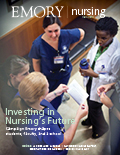Diversifying Nurse Leadership

Debbie Stevens is studying the impact of racial discrimination on caregivers and health outcomes among African Americans caring for family members with dementia.
Debbie Stevens, PhD Program
|
Reaching a Milestone: Scholarships: Faculty Research: Service-Learning: |
Debbie Stevens 00MN 13G APRN-BC—wife, mother of three, and third-year PhD student—can pinpoint the moment that changed her life. She was in a large Minneapolis conference room surrounded by hundreds of fellow psychiatric nurses. The year was 2008. She’d been a psychiatric advanced practice nurse for a decade.
“It was my first time away on a trip like this since I’d been married,” Stevens recalls. “I didn’t see a lot of others who looked like me because I was young and African American, and I looked around, wondering, ‘Where am I going in my nursing career? Why am I in the audience? Why am I not up on the stage presenting research?’ ” On the spot, she pulled out a notepad and wrote out two goals: to present research at the same conference the next year and enroll in a doctoral program.
By fall 2009, Stevens had checked both goals off her list with admission to Emory’s nursing PhD program and a poster presentation at the same conference.
Soon after, Stevens was pursuing research on the impact of racial discrimination on caregivers, with a specific look at health outcomes among African Americans caring for family members with dementia. “We know that discrimination is predictive of negative mental and physical health outcomes,” she says. “But what we don’t know is that if caregivers are experiencing additional stressors, how is that impacting their health?”
The topic hasn’t been addressed by researchers before and also is close to Stevens’ heart: the grandmother who raised her now lives with dementia. “It’s amazing to see how debilitating dementia can be,” Stevens says. “For someone who was like a mom to me and now not recognize me, it’s painful. Caring for someone like that can be a tremendous pull on caregivers.”
Her research got a big boost this past spring when she was named a Hartford Foundation Scholar for its Building Academic Geriatric Nursing Capacity Program. The scholarship provides $100,000 over two years, allowing Stevens to complete her research and attend academic and leadership training around the country. The foundation’s overall goal is to eliminate the shortage of geriatric nurse leaders in teaching and research.
Stevens has an additional goal as well—to help make sure other young African American nurses see leaders who look like them. “Health disparities are well-documented in the African American community,” she says. “To address them and bring solutions to the problems, we need more diversity in the health care workforce and also among researchers looking at the problems and trying to solve the issues facing African Americans. That’s something that keeps me going. I’m not just getting this PhD for me but for my community as well.”—Dana Goldman
Lasting ValueLast year, the School of Nursing awarded 404 merit and need-based scholarships to students, who on average received $6,000 to offset tuition costs. More than 80 percent of nursing students receive some form of financial aid. After graduation, the average debt load is $33,000 for BSN students and $30,000 or more for MSN students. Despite the cost, first- and second-career nursing students often work in underserved areas after they graduate. Their reason? “Students come here because of who we are,” says Katie Kennedy, director of financial aid and student success for the School of Nursing. |
||||



